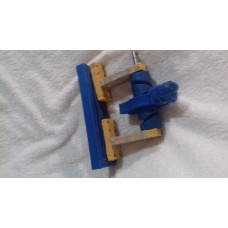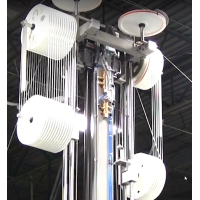level winder and spooler kit
If
you need to extrude your own filament besides the extrusion machine,
you will need to wind it nice and untangled,
if you have tangled filament you will need to re-spool it untangled,
if you have brittle annealed filament
on a regular spool and keeps breaking in the Bowden tube, you need to
soften it two hours at 50C if PLA, 70C if ABS, HTPET or PETG, 100C if
Nylon etc, than in the same hot setup you need to re-spool it on a
200mm large core spool (yes, you might need to make one out of a
200MM diameter bit of PVC pile and some thin plywood for sides) than
leave it re-spooled another 2 hours at same temperature, than let it
cool slowly, than you can print with it alright.
Always print
with 100% infill, PLA is good for a machine used now and than at room
temperature, if your machine will stay or be used in hot environment
(like a shed under sun) use at least ABS or PETG (none of them too
resistant in time, like PLA) or Nylon (PolyAmide) or PPS.
This
kit contains the following 3D printable items:
Level Winder
kit:
one twin left/right thread guide,
one path finder that will travel on that guide
one carrier for the path finder that also moves the filament left and right to avoid tangling on the spool
one stand leg (print two)
one stand base
one level winder breadboard base
one
pulley base diameter 100mm (to be fitted on the 8mm axis, it takes
all pulleys from 20mm diameter to 90 mm diameter)
Pulleys from 20 to 90mm diameter to be
fitted on the pulley base as needed
One pulley base diameter 220mm
(to be fitted on the 8 mm diameter axis, it takes the larger than 100
mm diameter pulleys)
one aligner to fit under the carrier
You
need to buy elsewhere: Inserts of metric 3 to put into the pulley
base 6 of them, one per each hole, metric 3 sunken head bolts various
lengths, stainless steel rod 8mm diameter that you need to cut at
175 mm and drill a hole diameter 3mm at 4 or 5 mm form one end
side to side to hold the bolt that locks the pulley, than when the
twin thread guide is printed, you drill through in the centre hole
with an 8mm diameter drill bit to clean the axis hole (those drill
bits are slightly less than 8mm, which is good, makes it a tight fit)
and than hammer through the axis hole the 8mm diameter rod such that
the end with the 3mm hole sticks out one side for 38/40mm.
You also need two stainless steel large
washers 8mm hole and 30mm outer diameter or whatever is near buy,
plus two 3mm bolts long 20mm for the aligner and 4 M4 bolts long 20
mm to bolt the legs onto the support, plus 4 M5 bolts long 25mm to
fit the assembly onto the breadboard support base.
After you
assembled the level winder and put the finder into the carrier, dry
run test it by hand while holding the finder down with one finger so
it does not pop out. If happy with the results that take a 3.5mm
drill bit and drill a hole in the side of it through the carrier side
opening, fit in an Allen key head bolt M3 with a nyloc nut to keep it
from flying out in operations.
level winder (no spooler) kit for filament 1.75 mm for 3 Kg spool
- Brand: 3D Mential
- Product Code: level winder (no spooler) filament 1.75 mm 3 Kg spool
- Availability: In Stock
-
£5.00
- Ex Tax: £5.00
Related Products
Filament accumulator kit
The production of 3D printer filament is hindered by a few major limitations, one being the requirement of uninterrupted filament extrusion without any changes in temperature, speed, or pulling tensioner. To address this, an accumulation buffer mechanism is needed to store the produced filament ..
£5.00 Ex Tax: £5.00
Tags: level winder, spooler kit, filament, 1.75 mm, 3 Kg spool, save the planet, climate change, plastic, reuse, recycle, recycling, repurpose, make your own filament, extrude filament, recuperate plastic, clean the environment.







